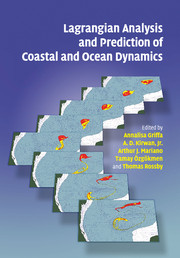Book contents
- Frontmatter
- Contents
- List of contributors
- Preface
- 1 Evolution of Lagrangian methods in oceanography
- 2 Measuring surface currents with Surface Velocity Program drifters: the instrument, its data, and some recent results
- 3 Favorite trajectories
- 4 Particle motion in a sea of eddies
- 5 Inertial particle dynamics on the rotating Earth
- 6 Predictability of Lagrangian motion in the upper ocean
- 7 Lagrangian data assimilation in ocean general circulation models
- 8 Dynamic consistency and Lagrangian data in oceanography: mapping, assimilation, and optimization schemes
- 9 Observing turbulence regimes and Lagrangian dispersal properties in the oceans
- 10 Lagrangian biophysical dynamics
- 11 Plankton: Lagrangian inhabitants of the sea
- 12 A Lagrangian stochastic model for the dynamics of a stage structured population. Application to a copepod population
- 13 Lagrangian analysis and prediction of coastal and ocean dynamics (LAPCOD)
- Index
- Plate section
- References
6 - Predictability of Lagrangian motion in the upper ocean
Published online by Cambridge University Press: 07 September 2009
- Frontmatter
- Contents
- List of contributors
- Preface
- 1 Evolution of Lagrangian methods in oceanography
- 2 Measuring surface currents with Surface Velocity Program drifters: the instrument, its data, and some recent results
- 3 Favorite trajectories
- 4 Particle motion in a sea of eddies
- 5 Inertial particle dynamics on the rotating Earth
- 6 Predictability of Lagrangian motion in the upper ocean
- 7 Lagrangian data assimilation in ocean general circulation models
- 8 Dynamic consistency and Lagrangian data in oceanography: mapping, assimilation, and optimization schemes
- 9 Observing turbulence regimes and Lagrangian dispersal properties in the oceans
- 10 Lagrangian biophysical dynamics
- 11 Plankton: Lagrangian inhabitants of the sea
- 12 A Lagrangian stochastic model for the dynamics of a stage structured population. Application to a copepod population
- 13 Lagrangian analysis and prediction of coastal and ocean dynamics (LAPCOD)
- Index
- Plate section
- References
Summary
Introduction
The prediction particle trajectories in the ocean is of practical importance for problems such as searching for objects lost at sea, tracking floating mines, designing oceanic observing systems, and studying ecological issues such as the spreading of pollutants and fish larvae (Mariano et al., 2002). In a given year, for example, the US Coast Guard (USCG) performs over 5000 search and rescue missions (Schneider, 1998). Even though the USCG and its predecessor, the Lifesaving Service, have been performing search and rescue operations for over 200 years, it has only been in the last 30 years that Computer Assisted Search Planning has been used by the USCG. The two primary components are determining the drift caused by ocean currents and the movement caused by wind. The results presented in this review are motivated by the drift estimation problem.
A number of authors (e.g., Aref, 1984; Samelson, 1996) have shown that prediction of particle motion is an intrinsically difficult problem because Lagrangian motion often exhibits chaotic behavior, even in regular and simple Eulerian flows. In the ocean, the combined effects of complex time-dependence (Samelson, 1992; Meyers, 1994; Duan and Wiggins, 1996) and three-dimensional structure (Yang and Liu, 1996) are likely to induce chaotic transport. Chaos implies strong dependence on the initial conditions, which are usually not known with great accuracy, so that the task of predicting particle motion is often extremely difficult.
Information
- Type
- Chapter
- Information
- Lagrangian Analysis and Prediction of Coastal and Ocean Dynamics , pp. 136 - 171Publisher: Cambridge University PressPrint publication year: 2007
References
Accessibility standard: Unknown
Why this information is here
This section outlines the accessibility features of this content - including support for screen readers, full keyboard navigation and high-contrast display options. This may not be relevant for you.Accessibility Information
- 3
- Cited by
